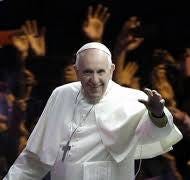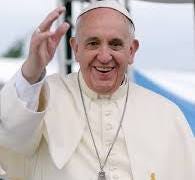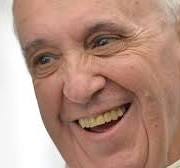My Momentous Meeting with Pope Francis
Even though He Wasn't Yet Pope When We Met and It Wasn't Momentous at the Time
In the light of his April 21 passing at age 88, I thought I’d join the global chorus of mourners and well-wishers and post a heartfelt piece about my momentous meeting with Pope Francis. It doesn’t matter that I’m a collapsed Catholic or that the significance I ascribe to the encounter isn’t spiritual.

He wasn’t yet Pope when I met him either. He was Cardinal Jorge Mario Bergoglio, the archbishop of Buenos Aires. Even so, I was surprised he had agreed to the meeting. I wasn’t the President or the VP. I wasn’t even the Ambassador, not that you had to be to meet with him then.
It was the fall of 2010, and I was the newly arrived political counselor at the US Embassy in Argentina. Because I had served as a diplomat focused on political affairs for the previous seven years in South America—first in Bolivia, then in Peru—I included Cardinal Bergoglio on a list of key figures to meet with early in my tour in Buenos Aires. I knew that, for all the dramatic slide in church-going on the continent amid generalized apathy and the rapid spread of evangelical movements, Catholic leaders remained plugged in politically. Particularly in the provinces, they tended to have their fingers on the pulse. In my experience, many are seasoned social observers and insightful political analysts, with lots of raw material and varieties of experience to choose from. They have an inside track into human striving and frailty, after all. As a result, some have a welcome edge of cynicism, leavened by irony and humor, and are genuinely fascinating and fun to speak with and listen to.
*****
In Bolivia, a brief meeting with Cardinal Julio Terrazas Sandoval in the department of Santa Cruz was always worth the time. And he typically gave my Bolivian colleague and I 15 generous minutes to bring us up to speed on the status of the department’s then-push for autonomy whenever we popped in to see him, which we did every several months. I recall he always greeted us warmly, appeared pleased to be able to help us make sense of an evolving situation (he was then serving a mediator role between department representatives and the central government in La Paz), and understood why diplomats from the American embassy would want to meet with him.
By the time I got to Peru in 2006, I had learned to make the first stop on any work trip to the provinces a “scene-setter” meeting with the local bishop, or any one of his senior subordinates. I found they generally had a broad understanding of the lay of the land, and provided a good framework for my subsequent conversations with the power structure: local government officials and political leaders, members of chambers of commerce, key business representatives, journalists, NGO, community, and indigenous leaders, and the like.
In Lima itself, I had had a memorable encounter with Cardinal Juan Luis Cipriani Thorne, a famously conservative member of Opus Dei who was archbishop of the sprawling capital city diocese at the time. In preparing for that meeting, I learned that the cardinal had played basketball in his youth and had been (rumor had it) a pretty good point guard back in the day. So I made that the starting point of our conversation. It was an interest we shared. During our conversation I recall he made several incisive observations about the then-mighty San Antonio Spurs, led by the great Tim Duncan. He noted that Duncan’s strong fundamentals, low-key style, and deep respect for his coach fit perfectly with the Spurs’ team-based approach, which he enjoyed watching and believed explained the team’s enduring dominance. He was clearly a fan. I also recall his concern that Hillary Clinton’s support for abortion rights could be corrosive for our body politic should she be elected president, which seemed likely at the time. It wasn’t a moment to push back.
So by the time I arrived as the US Embassy political counselor in Buenos Aires it felt normal and natural for me to request a meeting with the archbishop. But Cardinal Bergoglio was reportedly reluctant to meet with official Americans, so I was frankly surprised he had agreed to the meeting. I forgot why I had had this impression; I think it’s because I had heard that our Ambassador had requested a meeting with him several months before I arrived, and had never received a response. It might also be because he wasn’t known as a big fan of the USA, even under a somewhat like-minded President Obama. (Less so, now). When my meeting was confirmed, I double-checked that our Ambassador didn’t want to go in my stead (she didn’t) and decided to invite a young colleague who was serving as the human rights and religious freedom officer to come along. It was a professional opportunity, which shouldn’t be just mine.
*****
Before I describe the meeting itself, a few more words about the man. As I recall, Cardinal Bergoglio had the reputation back then of being serious and somewhat standoffish, disciplined in a no-nonsense way, and smart—in short, a quintessential Jesuit. And one whose fundamental “conservatism” didn’t mesh well with the then-far left government of Argentina, led by President Cristina Fernandez de Kirchner (CFK) and her husband and political partner in crime, former President Nestor Kirchner, who was still alive at the time. In fact, the feud between Argentina’s church and state was all but out in the open. The first couple never attended mass in Buenos Aires, and always commemorated big national events involving Catholic services outside of the capital city, usually in their home province of Santa Cruz. Cardinal Bergoglio’s views of the then-Argentine government, which were likely to be deeply-informed and probably unsympathetic, were a separate motive for a person in my position to seek a meeting.
I had high hopes for a scoop.
*****
Cardinal Bergoglio was courteous but cautious in our 10 or so-minute encounter. I recall he spoke about the church’s role in promoting dialogue and the importance of truly listening to one another in human affairs, especially politics. I interpreted this comment (tendentiously) as a jab at President Fernandez de Kirchner. (One prominent Argentine journalist later told me that the influence on the CFK government of German national socialist political philosopher Karl Schmitt, particularly his focus on the implacable fight between “friend” and “enemy”, had made dialogue between opposing political forces in Argentina all but impossible. Little did I know that this was a preview of coming attractions at home—see here). After our brief exchange of niceties and platitudes, during which I mostly nodded and murmured words of assent, and then added a brief comment about how dialogue was central to what diplomats try to do too, the meeting was over.
It felt more perfunctory than momentous, more like a one-off courtesy call than the beginning of a beautiful friendship. I hadn’t managed to break the ice, as I could sometimes do with a well-posed question or a comment reflecting genuine curiosity or advance preparation. Oh well, one’s plans don’t always pan out. Not all meetings are substantive, and you can’t hit it off with everyone. We shook hands, said our adioses, and my colleague and I departed—walking down the dark corridor alongside the cathedral toward the busy downtown boulevard. Which is where I thought our story would end.
But then, two short years later, on March 13, 2013, Cardinal Bergoglio emerged from his relative obscurity in Argentina to become perhaps the most familiar public figure in the world. All of a sudden, as my young colleague put it, we had met the Pope! (Too bad I hadn’t taken a photo for my Washington DC office’s de rigueur “I love me” wall for political strivers, which I don’t now have and never did).
*****
Bergoglio’s metamorphosis into Francis reminded me a bit of a homely caterpillar suddenly becoming a colorful butterfly. Overnight, he was transformed from a plainspoken Jesuit cardinal with a reputation for orneriness and relatively conservative—at least in the Argentine context—political views, into a liberal “Franciscan”-style pope with a gift for humility, a forward-leaning social agenda, and inclusive political views. It reminded me again of the power of the media in creating public perception, of public information campaigns in propagating public understanding. This has nothing to do with “truth” or “falsehood,” only with the way identity can shift in changing circumstances and with the often uncertain relationship between private reality and public image. It happens again and again.
Given the global swoon that accompanied his ascendance to the pinnacle of the Catholic Church hierarchy, and the warm blanket of memory that envelops most people—particularly public figures like Pope Francis—in death, it is ironic to recall that his papacy was greeted with skepticism in his home country. At least by supporters of the then-government. At least at first. For example, official media organs published reports of Bergoglio’s alleged collaboration with Argentina's brutal military junta regime between 1976-1983. I recall several critical hit-type pieces included insinuations of his (indirect) involvement in the disappearance of two young radical Jesuit priests, who actively opposed the regime and collaborated with underground militant groups. On that note, I remember meeting with an American journalist who had been sent to Buenos Aires by a well-known US news magazine on a stringer assignment a week or so after the conclave had publicly announced the new pope. The journalist told me he was unlikely to publish anything unless he found “dirt”—the kind of thing that sells copy.
I told him I probably couldn’t help him. From the reading and other research I had done, including speaking with knowledgeable Argentine friends about him, the new pope had conducted himself with great political astuteness as a senior church leader during that dicey period in the country’s recent past. While the most notorious junta leader, General Jorge Videla, had practiced his Catholicism in cloyingly public fashion, and some Church leaders were indeed openly sympathetic to the military regime’s “process of national reorganization” and rabid anti-communism, Bergoglio himself had navigated the sensitive political terrain quite skillfully. He had taken pains to maintain his independence from politics, to avoid provoking the military regime. He had never supported any underground opposition group (apart from providing occasional pastoral succor to individuals), but neither had he collaborated in any nefarious way with the regime, so far as I knew. He had maintained a cautious and distant working relationship, worked pragmatically within the frame of political reality, as a politically-minded priest would.
*****
As much as his moral character, his spiritual teachings, and his pastoral skills, Bergoglio’s keen political instincts had served him well. Judging by his ascension to the Church’s highest office, the first Jesuit, the first Latin American, and the first representative of the global South to sit on that highest of high earthly thrones, his ability to navigate precarious political terrain, honed over years of experience in his home country, had served him very well.
Goodbye, Archbishop Bergoglio. Farewell, Pope Francis. Adios.






A great memory for you and an interesting story for us. Thanks for sharing it.
Love these sentences and the turns of phrases in them: “They have an inside track into human striving and frailty, after all. As a result, some have a welcome edge of cynicism, leavened by irony and humor…”. Thanks for sharing that.
Depressing how omnipresent Karl Schmitt is these days. I hadn’t thought about the guy since graduate school and now he’s everywhere, just like Frederick Douglass was in the first term.